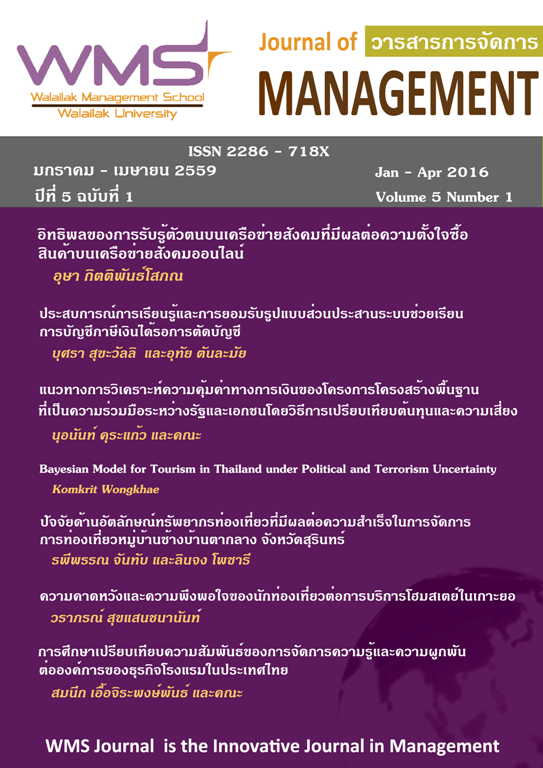The Comparative Relationship of Knowledge Management and Employee Engagement of Hotel business in Thailand
Main Article Content
Abstract
The purposes of this research were to study and compare the relationship between knowledge management and employee engagement of organizational hotel business in Thailand. To the decision to choose the strategy or assignment is to develop and maintain a policy of human resources in organizations. The quota sampling population consisted of 328 Hotels from the 4 and 5 star hotels which were certified and approved from the Tourism Authority of Thailand (TAT). The research instrument was questionnaires was used to collect data and use the statistics to analyze the frequency, percentage, mean, standard deviation, t-test, F-test and Pearson's Product-Moment Coefficient.
The finding showed that 5 star hotel offers a level of process knowledge management and employee engagement to the organization over a 4 star appearance ownership and membership in the Institute of Hotel on the factors of knowledge management and commitment. No association Organization During the opening of the hotel at least 20 years, with the most knowledge management processes. During the opening of the hotel's 20 years or above with most organizational commitment as well and the number of staff with appropriate knowledge management processes and organizational commitment of over to 200 people at a significance level of 0.05.Article Details
References
กรมการจัดหางาน. (2557). สถานการณ์การว่างงาน การเลิกจ้างและความต้องการแรงงาน. สืบค้นเมื่อ 15 พฤศจิกายน 2557, สืบค้นจาก http://www.m-society.go.th/article_attach/11941/16207.pdf.
กระทรวงการท่องเที่ยวและกีฬา. (2554). แผนพัฒนาการท่องเที่ยวแห่งชาติ พ.ศ. 2555-2559. กรุงเทพฯ: กระทรวงการท่องเที่ยวและกีฬา.
การท่องเที่ยวแห่งประเทศไทย. (2557). สถานการณ์การท่องเที่ยวตลาดต่างประเทศไตรมาสที่ 2/2557. จุลสารวิชาการการท่องเที่ยวการท่องเที่ยวแห่งประเทศไทย, 3(4), 8-15
ทิพย์รัตน์ อติวัฒนชัย. (2550). การจัดการความรู้ในวิทยาลัยบัณฑิตศึกษาการจัดการมหาวิทยาลัยขอนแก่น. การศึกษาอิสระปริญญามหาบัณฑิต, มหาวิทยาลัยขอนแก่น.
นงค์นุช ศรีธนาอนันต์. การโรงแรมเบื้องต้น. กรุงเทพฯ. มหาวิทยาลัยธุรกิจบัณฑิต
ประเวศ วะสี. (2545). การจัดการความรู้. สานปฏิรูป, 5(5), 74–76
พรธิดา วิเชียรปัญญา. (2547). การจัดการความรู้พื้นฐานและการประยุกต์ใช้. กรุงเทพฯ: เอ็กซ์เปอร์เน็ท
วิจารณ์ พานิช. (2547). ความรู้ยุคใหม่อยู่ใน คน มากกว่า ตำรา. วารสารสานปฏิรูป, 7(80), 62-68.
สมนึก เอื้อจิระพงษ์พันธ์. (2553). รูปแบบการพัฒนาความสามารถในการจัดการความรู้ของผู้ประกอบการที่มีนวัตกรรมในประเทศไทย. กรุงเทพฯ: จุฬาลงกรณ์มหาวิทยาลัย.
Bolloju, N. Khalifa, M. Turban Integrating E. (2002). Knowledge management into enterprise environments for the next generation decision support. Decision Support Systems, 33 (2), 163-176
Buchanan, B. (1974). Building organization commitment: The socialization of manager in Work organization. Administrative Science Quarterly, 19(40), 533-546
Burke. (2003). Employee Engagement. Retrieved , November 16, 2014 From http://www.burke.com.
Croasdell, D. T. (2001). IT's role in organizational memory and learning. Information Systems Management, 18(1), 8-11
Cronbach, L.L. (1990). Essentials of psychological testing. Portland: Harper Collins Publishers, Inc.
Davenport, T. (2009). Some principles of knowledge management. Retrieved November 15, 2014 , From http://www.bus.utexas.edu/kmam/kmprin.htm.
Dessler, G. (1993). Winning Commitment: How to build and keep a competitive workforce. New York: McGraw-Hill.
Development Dimensions International. (2005). Employee engagement: The key to realizing competitive advantage. Retrieved November 29, 2014, From http://www.ddi.com/pdf/ddi_employee engagement_mg.pdf
Freeze, R.D. (2006). Relating Knowledge Management Capability to Organizational Outcomes. Ph.D. Dissertation. Arizona State University.
George, J.M., & Jones, G.R. (1996). Organizational behavior: understanding and management. New York: Addison-Wesley
Greenberg, J. & Baron, R.B. (2000). Behavior in organizations. (7th ed.). Englewood Cliffs, NJ: Prentice-Hall.
Gubman, L.E. (2004). The Talent Solution: Aligning Strategy and People to Achieve Extraordinary Results. USA: McGraw-Hill.
Hartline, M. D., Jones, K. C. (1996). Employee performance cues in a hotel service environment: Influence of perceived service quality, value word of mouth intention. Journal of Business Research, 35, 207-215.
Hewitt Associate. (2004). Making the connection (Online). Retrieved January 12, 2014 From http://www.hewitt.com
Inkpen, A.C. (1998). Learning and knowledge acquisition through international strategic alliances. Academy of Management Executive. 12, 69 – 80.
Institute for Employment Studies. (2004). The drivers of employee engagement. Retrieved January 12, 2014 From http://www.employmentstudies.co.uk/summary/summary.php?id=408.
Laudon, K. and Laudon, J. (1998). Management information systems: Organization and technology in the networked enterprise. 6th edition. N.J.: Prentice-Hall.
Lloyd, R. (2008). Discretionary effort and the performance domain. The Australian and New Zealand Journal of Organizational Psychology, 1(1), 22-34
Malhotra, Y. (2000). Knowledge Management and New Organization Forms: A Framework for Business Model Innovation, Information Resources Management Journal, 13(1), 5-14.
Mandarin Oriental Hotel Group. (2014). โรงแรมแมนดาริน โอเรียนเต็ล บางกอก. Retrieved January 12, 2014 From http:// www.thainesscapital.com/14410696/%E0%B9%82%E0%B8%A3%E0%B8%87%E0%B9%81%E0%B8%A3%E0%B8%A1%E0%B9%82%E0%B8%AD%E0%B9%80%E0%B8%A3%E0%B8%B5%E0%B8%A2%E0%B8%99%E0%B9%80%E0%B8%95%E0%B9%87%E0%B8%A5
Marquardt, M.J. (1996). Building the Learning Organization. New York: McGraw-Hill.
Marquardt, M.J. (2002). Building the learning organization: A systems approach to quantum improvement and global success. New York: Mc Graw-Hill.
Narayanan, V. K. (2001). Managing technology and innovation for competitive advantage. NJ: Prentice Hall.
Neale, M. A., & Northcraft, G. B. (1991). Behavioral negotiation theory: A framework for conceptualizing dyadic bargaining. In L. L. Cummings &B. M. Staw (Eds.), Research in organizational behavior. 13, 147–190.
Porter L., et. al., 1974. Organizational commitment, job satisfaction, and turnover among psychiatric technicians. Journal of Applied Psychology, 5(Oct), 603-609
Sigala, M. and Chalkiti, K. (2007). Improving performance through tacit knowledge externalization and utilization: preliminary findings from Greek hotels, International Journal of Productivity and Performance Management, 56(5), 456-83.
Steers, R.M. (1977). Antecedents and Outcomes of Organizational Commitment. Administrative Science Quarterly, 22(March), 46-56.
Steers, R.M. & Porter, L.W. 1983. Motivation and Work Behavior. New York: McGraw – Hill.
The Gallup Organization. (2003). Understanding employee engagement. Retrieved January 15, 2014, From http://www.frequentlyasked.info/articles/?q=node/88.
Tobin, T.. (2009). Ten principles for knowledge management success. Retrieved November 15, 2014, From http://www.knova.com/docs/whitepapers/Knova-Whitepaper-TenPrinciplesForKM.pdf.
Towers Perrin. (2007). Closing the engagement gap: A road map for driving superior business performance. Retrieved November 15, 2014, From http://www.biworldwide.com/info/pdf/Towers_Perrin_Global_Workforce_Study
Vance R. J. (2006). Employee Engagement and Commitment. USA: SHRM Foundation.
Watts, A.G. 2001. Career Education for Young People: Rationale and Provision in the UK and Other European Countries. International Journal for Educational and Vocational Guidance, 1(3). 209-222.
Wellins,R and Concelman,J. 2005. Creating a Culture for Engagement. Retrieved January 12, 2014 From http://www.WPSmag.com
Yamane, T. (1973). Statistic: An Introductory Analysis. 3 rd ed. New York: Harper and Row.
Yang, Chyan & Chen, Liang-Chu. (2007). Can Organizational Knowledge Capabilities Affect Knowledge Sharing Behavior ?. Journal of Information Science, 33(1), 95-109.
Zheng, Wei. (2005). The Impact of Organizational Culture, Structure, and Strategy on Knowledge Management Effectiveness and Organizational Effectiveness. Ph.D. Dissertation. University of Minnesota.


